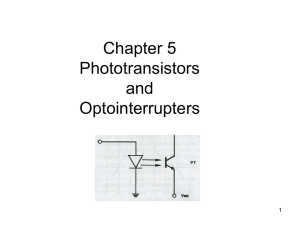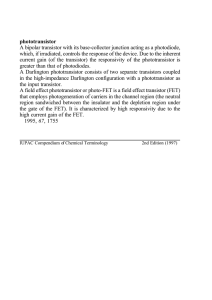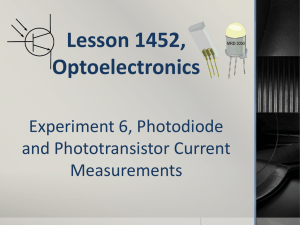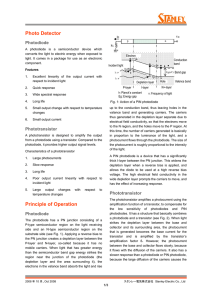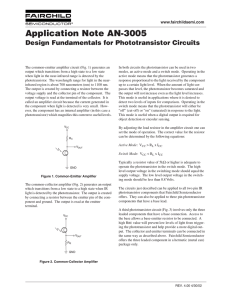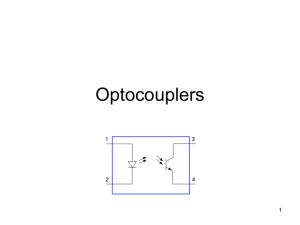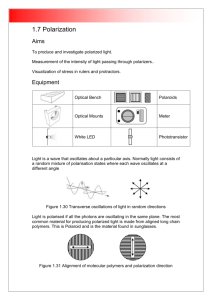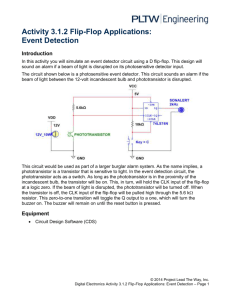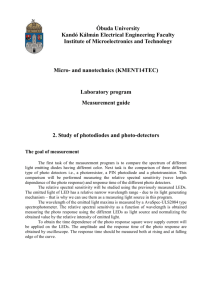3.4 Photodiodes and Phototransistors.
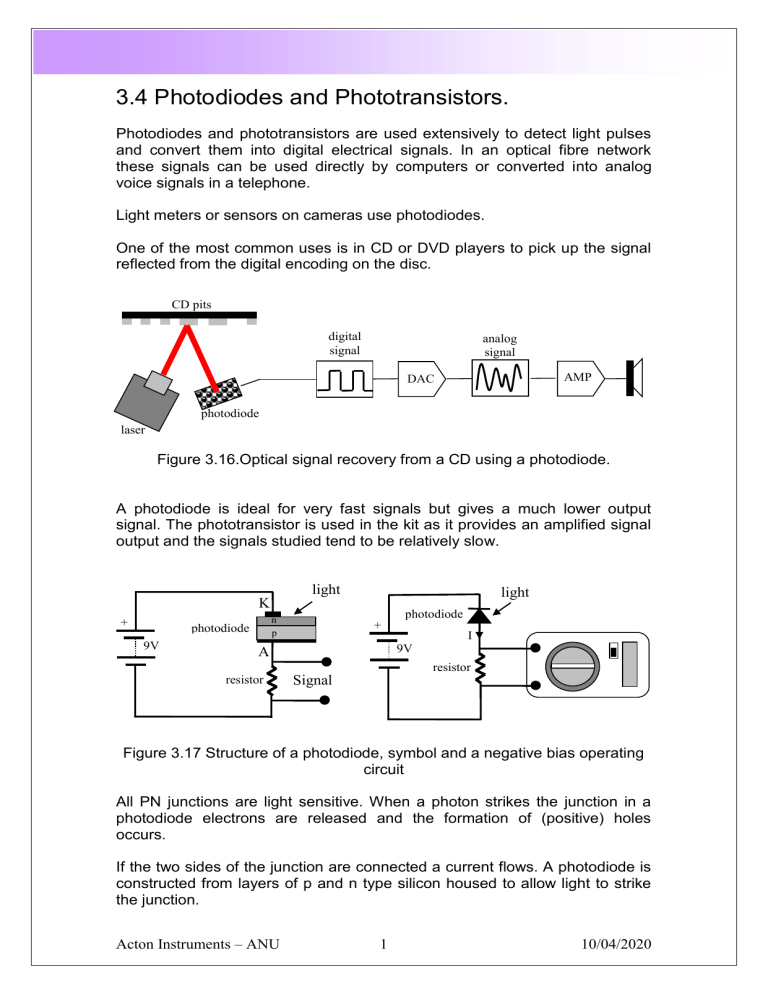
3.4 Photodiodes and Phototransistors.
+
Photodiodes and phototransistors are used extensively to detect light pulses and convert them into digital electrical signals. In an optical fibre network these signals can be used directly by computers or converted into analog voice signals in a telephone.
Light meters or sensors on cameras use photodiodes.
One of the most common uses is in CD or DVD players to pick up the signal reflected from the digital encoding on the disc.
CD pits laser photodiode digital signal
DAC analog signal
AMP
Figure 3.16.Optical signal recovery from a CD using a photodiode.
A photodiode is ideal for very fast signals but gives a much lower output signal. The phototransistor is used in the kit as it provides an amplified signal output and the signals studied tend to be relatively slow.
9V photodiode
K
A resistor n p light
Signal
+ photodiode
9V
I resistor light
Figure 3.17 Structure of a photodiode, symbol and a negative bias operating circuit
All PN junctions are light sensitive. When a photon strikes the junction in a photodiode electrons are released and the formation of (positive) holes occurs.
If the two sides of the junction are connected a current flows. A photodiode is constructed from layers of p and n type silicon housed to allow light to strike the junction.
Acton Instruments – ANU 1 10/04/2020
+ c light light
9V photo transistor resistor e n p n
Signal
+
9V photo b transistor resistor c e
Figure 3.18 Phototransistor structure, symbol and operating circuit
In a phototransistor photons strike the base region of the transistor. This causes current to flow through the collector/emitter circuit and in effect amplification occurs. The base connection is not usually connected.
Phototransistors, figure 3.19 come in a variety of forms and may resemble a
LED with only two leads. Try the device both ways round. e b c e c e b c
BPX 43
Figure 3.19 Phototransistor pin outs
Refer to figure 3.18 and build the circuit on the breadboard so the phototransistor faces the white LED on the optical table as shown in figure
3.20.
The phototransistor is a BPX 43 and the pin out is shown in figure 3.19.
Start off with R1 at 1M
and record the voltage level on the meter.
If the photodiode is too close to the LED the device may saturate and not respond to the light level. Replace the resistor with the other values available in turn; taking care not to move the positions of the components. Complete the table. resistor 1M
560K
270K
100K
10K
1K
volts
Plot a graph to show the voltage output against the resistor value. It may be necessary to take background light levels into account.
Acton Instruments – ANU 2 10/04/2020
meter
Photo transistor LED
Analog in Analog out Photodiode 1 Photodiode 2 BNC & LED BNC & LED
Figure 3.20 Phototransistor and LED on the optical bench
The response of the phototransistor to different light levels can be investigated by selecting a resistor that gives close to maximum output (but doesn't saturate). Place neutral density filters between the phototransistor and the LED.
% transmission
100 50 25 13 7
Voltage output
To extend the number of samples use combinations of the filters Calculate the percentage transmission of each filter combination.
Plot a graph to display the results and explain the shape of the graph. Think of a suitable application for a detector of this type. It may be necessary to take background light levels into account.
Acton Instruments – ANU 3 10/04/2020
The frequency response to pulses of light or changes in light levels is important in many applications. The phototransistor can be configured to give different response rates. Set up the optical bench and oscilloscope as shown in figure 3.21. photo circuit
Rx recover Rx fibre
Rx black Tx blue Tx keyboard rate switch 5V 5V volt/div volt/div secs/div ch1 ch2 trig
Figure 3.21 Pulse response rates.
The light output from a length of fibre inserted in the digital transmitter should cause a response on the oscilloscope screen. The oscilloscope should be attached to the output from the phototransistor.
Oscilloscope settings are Trigger None, Volts /Div 5V and Secs Div typically
20mS at the low flash rate and 100uS/div at the maximum rate.
Start with the 1M
resistor and note the response at the maximum and minimum flash rates. Sketch the waveforms seen on the oscilloscope.
1M
560K
270K
100K
Acton Instruments – ANU
10K
4
1K
10/04/2020
Replace the 1M
Resistor with the other values and repeat the exercise. c b e
Figure 3.22 Electronic model of a phototransistor
Try to explain why the output pulses have changed at the higher flash rates.
Reference to figure 3.22 may help.
As a further experiment switch between the DC-GND-AC switch on the oscilloscope and note what happens to the display. light
+ photo transistor b c
9V e capacitor resistor oscilloscope
Figure 3.23 De-coupling capacitor used to remove DC
Switch back to DC and modify the phototransistor circuit with a 0.15uF capacitor between the output and oscilloscope lead as shown in figure 3.23.
Explain the action of the capacitor. This is a very important property used later in the construction of transistor amplifiers.
Acton Instruments – ANU 5 10/04/2020
